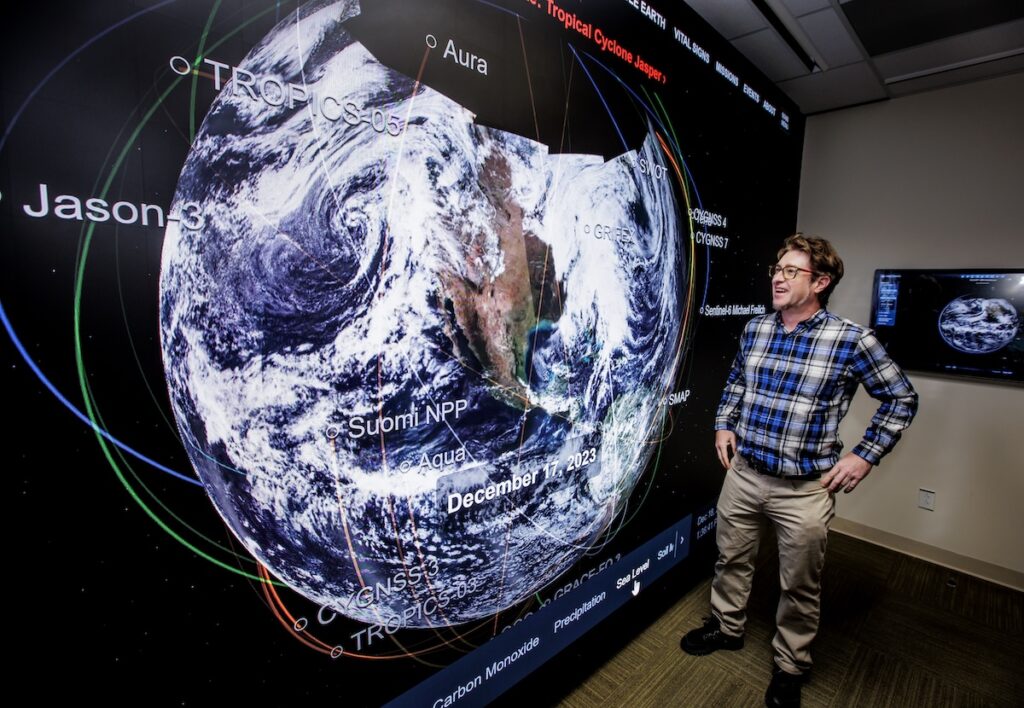
The Jet Propulsion Laboratory holds a unique role in L.A.’s space industry, though its work extends past exploration of distant planets and constellations. The lab, located in La Cañada-Flintridge, has a strong Earth Science Section that is launching innovative satellites and conducting deep research on our own world in a series of upcoming missions.
JPL is managed by the California Institute of Technology and is the National Aeronautics and Space Administration’s only federally funded research and development center. The lab has partnered with other international space agencies, in addition to local companies including Pasadena-based Motive Space Systems Inc. and Hawthorne-based SpaceX, and primarily functions to construct and operate planetary robotic spacecraft.
JPL and NASA have a strong impact on the region’s economic and employment landscape, as well as California’s role in the national aerospace industry. JPL has more than 6,300 employees and, according to NASA’s 2022 Economic Impact Report, NASA’s activities in California in 2021 totaled $15.2 billion in economic output and $738 million in tax revenue for state and local governments. JPL designed, built and operated the first U.S. satellite, Explorer 1, as well as all five of the successful rovers that have been sent to the surface of Mars so far.
However, Michelle Gierach, principal scientist for JPL’s Earth Science Section, said she has found that people often underestimate how much of JPL’s work and research is focused on our planet. JPL has four Earth science-related missions coming up this year and is assisting with NASA’s Earth System Observatory. The Earth System Observatory is a series of missions designed to work in tandem to inform climate change mitigation and disaster relief efforts through long-term observations of Earth. Several of the missions, including SWOT, are managed or partially led by JPL.
“Generally, people are a little bit surprised sometimes to find out how much we actually do with respect to Earth science,” Gierach said. “First and foremost, we do a lot of Earth science and have a very healthy portfolio of upcoming Earth missions.”
Aquatic focus
Gierach joined JPL in 2011 as a project scientist for the Physical Oceanography Distributed Active Archive Center and has a focus on aquatic biogeochemistry. In addition to her position as a principal scientist, Gierach was appointed associate scientist for the Earth Science and Technology Directorate last year.
Upcoming Earth missions include the NASA-ISRO Synthetic Aperture Radar, or NISAR, which is scheduled to launch early this year to observe and measure natural processes such as ice-sheet collapses, earthquakes, tsunamis, volcanoes and landslides. Gierach said that many current and upcoming Earth science missions will gather actionable data to bolster public- and private-led efforts to understand and mitigate climate change’s effects on human health. NISAR is a partnership between NASA and the Indian Space Research Organization, and its U.S. component will be led by JPL. Gierach said that missions like NISAR will help fill in lingering gaps in NASA’s scientific understanding of the planet.
“In the past, we’ve done great technological innovations to do scientific discovery and then we might have ended there, full stop,” Gierach said. “Now it’s all about, ‘how do we do that technological innovation for scientific discovery for societal benefit and action?’ That’s really the thrust of all of these missions that we have going forward, both at JPL as well as NASA headquarters … all the missions are rooted in some kind of aspect of (societal benefit) and understanding the Earth’s system to better inform that.”
Exploring Earth
In a list of priorities that JPL director Dr. Laurie Leshin set for the next two years, the lab seeks to expand its role as a facilitator and promoter for NASA’s Earth science missions. Leshin wrote that, in its pursuit of “scientific discoveries that benefit humanity,” JPL will work to invent or leverage new technologies to drive scientific exploration of Earth’s natural processes and systems.
In addition to its design and construction work, JPL has more than 40 active missions and operates the NASA Deep Space Network. The lab garners significant funding from NASA; it had an operating budget of about $2.4 billion in 2022, and NASA’s proposed congressional budget for fiscal-year 2024 would put about $949 million toward the proposed Mars Sample Return mission that would be operated by JPL.
“NASA and NASA Science, which is kind of the area we fall in, is very much supported bipartisanly,” Larry James, JPL deputy director, said to the Business Journal in April. “I think that’s certainly been evidenced in the fact that our budget has gone up, and NASA’s overall budget has gone up, over the last few years.”
Gierach called 2023 the “year of open science” where, as part of NASA’s ongoing effort to make its discoveries more publicly available, several new doctrines and policies were enacted by NASA to remove any period of prior exclusivity to its data. In line with this, NASA began releasing data from its Surface Water and Ocean Topography mission on Nov. 30, and more data will be published this month. Satellite measurements from the SWOT mission are already being used to inform construction plans for a large hydroelectric dam in Egypt’s Nile River Basin.
SWOT was launched in 2022 and is the first satellite mission to observe nearly all water on Earth, including oceans, lakes, rivers and reservoirs. JPL is leading the U.S. component of the mission and said that the information gathered by SWOT will allow NASA to see how the ocean is influenced by and reacts to climate change and monitor water resources in a higher definition than ever before. Gierach said that measuring the height and area of inland water bodies, such as rivers, is crucial to understanding how climate change is accelerating Earth’s water cycle. This data will be important to inform resource-preparation plans amid intermittent droughts and increasing temperatures.

“SWOT is providing unprecedented observations with respect to new ocean features and has also been showing some really cool things that we haven’t seen before, like internal waves,” Gierach said. “(It’s) unprecedented for coasts, unprecedented for ocean, first-ever (spaceborne) observation of inland water … this is really groundbreaking, and the great societal applications that can be associated with that are key.”
The SWOT mission is also looking at how the ocean is absorbing carbon heat in order to bolster hurricane forecasting abilities and increase information about rising sea levels. Gierach said that as hurricanes and tropical cyclones approach land they interact with circulating water and can be significantly intensified or deintensified by the water’s temperature. Warm water, which usually sits deeper below the surface, can rapidly increase the storm’s severity, while cold water usually quickly weakens it.
“Previous (satellites) have really been unable to resolve near-coastal impacts, which clearly, for society, is most important,” Gierach said. “With SWOT, we can really see those deintensification features … we can make a better prediction as to how they will intensify or not and then therefore the implications that’s going to have upon the coastal communities with respect to storm surges, flooding, inundation, all of those factors.”
Climate change research
As for its Earth science department, JPL recently designed and built an imaging spectrometer for Pasadena-based nonprofit Carbon Mapper Inc., which will collect data on methane and carbon dioxide to inform climate change monitoring and mitigation efforts. The initiative is slated to launch early this year.
Gierach said JPL has been abuzz with conversation about the Surface Water and Ocean Topography mission’s data release and the impending launch of the NASA-ISRO Synthetic Aperture Radar, and that she is excited about the scientific applications that SWOT’s findings will offer to governments and decision makers.
In addition to the upcoming NASA-ISRO Synthetic Aperture Radar mission, JPL is launching a series of small satellites midyear to look at how poles act as a thermostat for the Earth, and is moving deeper into work on the 2025 launch of the Multi-Angle Imager for Aerosols mission. MAIA is a partnership between NASA and the Italian Space Agency that will study the impacts of various types of airborne matter on human health.
“I’m never bored, there’s always something fun and exciting that’s happening here,” Gierach said, “Earth science has a very robust portfolio so there’s always a new mission that I can be exploring and see the connections with, but, in the near term, the science and applications that are going to come from SWOT are the highest priority and (are) exciting.”
